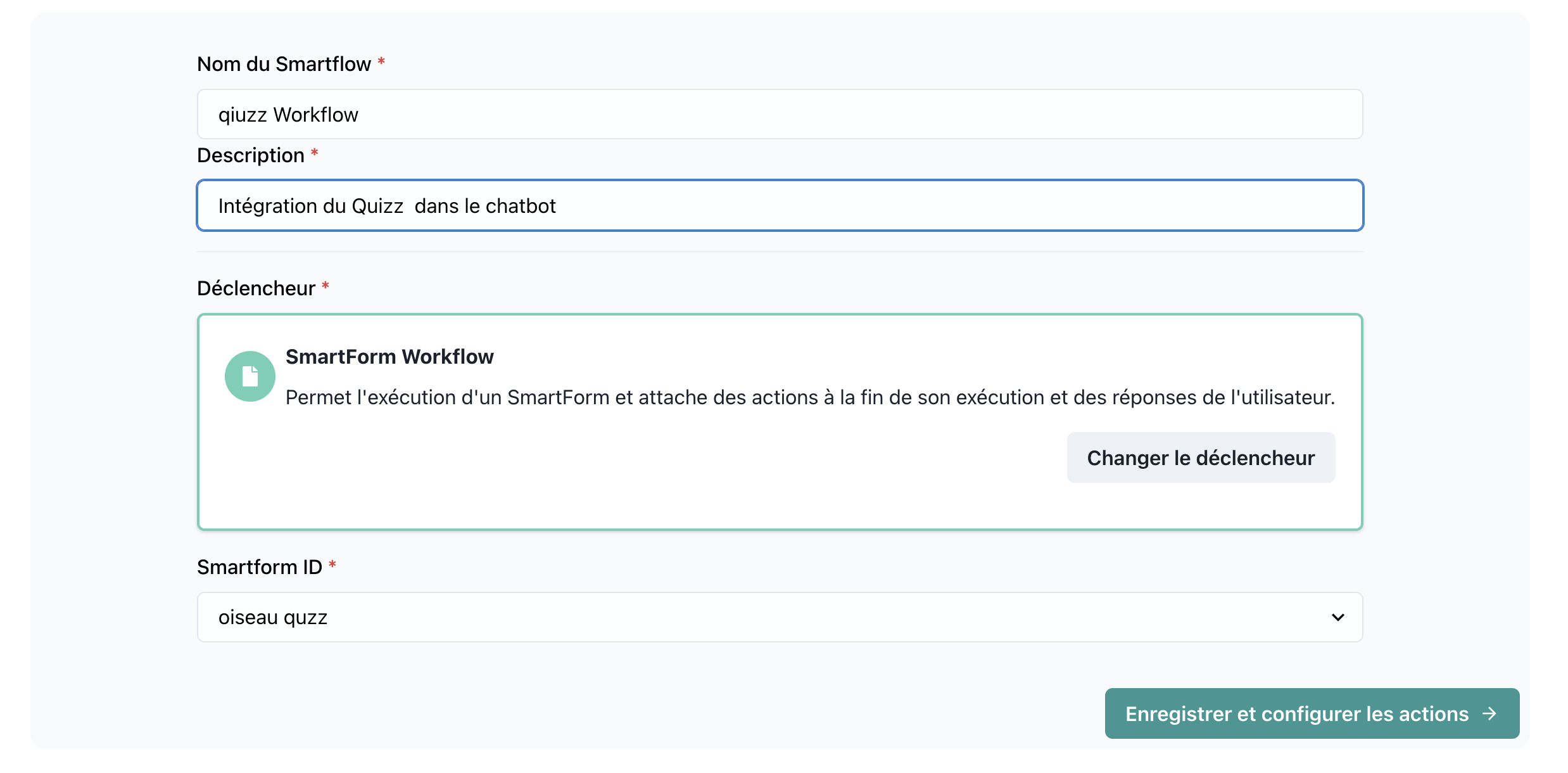📋 SmartForm als Gespréichs-Tool
De SmartForm Trigger déngt als Entréepunkt fir Workflows andeems et Benotzeräntwertungen duerch e Formulaire sammelt. All gesammelten Donnéeën, inklusiv AI-berechent Resultater (wann aktivéiert an der Formulairekonfiguratioun), ginn un SmartFlow weidergeleet. Et erlaabt Iech, Formulardonnéeën dynamesch an Äre Workflows ze benotzen an logikgetriebene Aktiounen ze kreéieren.

📝 Trigger Detailer
Numm: SmartForm
Kategorie: Triggers
📝 Trigger Detailer
Numm: SmartForm
Kategorie: Triggers
🔧 Parameter
1. Form ID
- Typ:
string - Beschreiwung: Den eenzegaartegen Identifikator vum SmartForm.
- Erforderlech: Jo
- Beispill:
form12345
2. Form Reaktiounen
- Typ:
object - Beschreiwung: Enthält all Froen a seng entspriechend Äntwerten, déi als Variabelen an SmartFlow Aktiounen benotzt kënne ginn.
- Erforderlech: Jo
- Beispill:
{
"name": "John Doe",
"email": "john.doe@example.com",
"age": 30,
"feedback": "Great service!"
}
3. Observatioun
- Typ:
string - Beschreiwung: Setzt d'Observatioun fir d'AI no der Ofschloss vum Formulaire. Standardméisseg ass dëst d'AI-berechent Resultat oder d'Äntwerten vum Formulaire. Dir kënnt et awer manuell personaliséieren.
- Erforderlech: Optiounnel
- Standardwäert: D'Resultat oder d'Äntwert vum Formulaire.
🚀 Wéi et funktionéiert
-
Formulaire Complettéierung:
- Benotzer interagéieren mat dem SmartForm an ginn Äntwerten op d'Froen.
-
Resultat Handhabung:
- Eemol dat Formulaire agereecht ass, kritt SmartFlow:
- All Formulardaten: All Fro an Äntwert als Variabelen.
- Resultat (wann aktivéiert): AI-berechent Resultater baséiert op den Entréeën vum Benotzer.
- D'Beobachtung ass entweder op d'berechent Resultat oder d'Default Formulardaten gesat.
- Eemol dat Formulaire agereecht ass, kritt SmartFlow:
-
Variabelen am Workflow:
- All Fro an Äntwert ass verfügbar fir benotzt ze ginn an SmartFlow Aktiounen.
- Beispill: Benotz
{name}oder{feedback}an enger E-Mail-Aktioun.
💡 Benotzungscasen
1. Personaliséiert Onboarding
- Szenario: Benotzt SmartForms fir Benotzerinformatiounen während dem Onboarding ze sammelen.
- Workflow:
- Variabelen aus dem Formular (z.B. Numm, Alter) ginn benotzt fir d'nächst Schrëtt ze personaliséieren.
- Beispill: Benotzer engem spezifesche Client Success Manager zouweisen baséiert op hiren Äntwerten.
2. Ëmfro Analyse
- Szenario: Feedback sammelen an et dynamesch analyséieren.
- Workflow:
- Benotzt AI-berechent Resultater fir d'Gefill ze bewäerten.
- Variabelen wéi
{rating}an{feedback}ginn benotzt fir passend Aktiounen ze ënnerhuelen.
3. Dynamesch Entscheedungsfäegkeet
- Szenario: Erlaabt SmartFlow Entscheedungen ze treffen baséiert op Benotzeräntwerten.
- Workflow:
- Froen am Formular (z.B.
{role}) leeden zu den nächsten Schrëtt vum Workflow.
- Froen am Formular (z.B.
🔍 Beispill Konfiguratioun
Form ID:
customerFeedbackForm01
Form Froen:
{
"name": "string",
"email": "string",
"feedback": "string",
"rating": "number"
}
Observatioun:
"Feedback Analyse komplett. Sentiment: Positiv."
🛠️ Tipps
-
Observatioun Kontroll:
- Manuell d'Observatioun setzen fir d'Aktioun vum AI ze beaflossen. Zum Beispill:
"Start eng nei Workflow baséiert op den Formulardaten."
- Manuell d'Observatioun setzen fir d'Aktioun vum AI ze beaflossen. Zum Beispill:
-
Debugging:
- Teste Formulaireinsendungen fir sécherzestellen, datt all Variabelen korrekt un SmartFlow iwwergaange ginn.
-
Resultat Geneeheet:
- Wann d'Resultatberechnung aktivéiert ass, stellt sécher, datt d'AI Logik am Formulaire korrekt konfiguréiert ass fir genee Resultater.